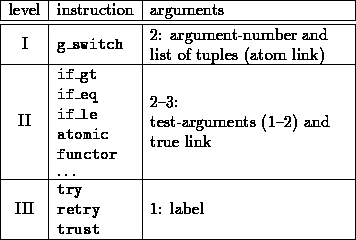In [HM89] Timothy Hickey and Shyam Mudambi present several indexing techniques based on the WAM. The first one (complete indexing) uses global information (like modes) to perform indexing.
First of all the program is transformed, creating new special code for each mode that might occur for a procedure call.
As an example we look at the following program:
1. top :- p([1,2,3,4],X), write(X). 2. p([],0). 3. p([X|Y],N) :- p(Y,M), N is M+1.
p is only called with a constant argument in the first position and a
variable in the second. The new code for the procedure p is
specialized for this mode. It is represented in the procedure
p_cd![]() . If we assume
that the program p is also called with other modes, the compiler will
produce other specialized procedures for these modes.
. If we assume
that the program p is also called with other modes, the compiler will
produce other specialized procedures for these modes.
The transformed source program is:
1. top :- p_cd([1,2,3,4],X), write_c(X). 2. p_cd([],0). 3. p_cd([X|Y],N) :- p_cd(Y,M), N is M+1.
Then the clauses are transformed into a normal form:
1. p_ccdd(
2.
3. .
Where:
The generated indexing code is in some sense also a three level indexing (c.f. section 4) of the following form:

The first one is a sequential indexing on the first c-mode
arguments. This is done by unifying the known structure of these
arguments and indexing inner different possibilities with a new
index-instruction called g_switch reg table. This new
instruction assumes that the argument register reg contains a ground
term, and switches to the appropriate location after a hash-table look
up in table.
The indexing primitive code contains a set of new WAM branch instructions (e.g. if_gt, if_eq, if_le), so control jumps to a given label based e.g. on arithmetical comparisons.
The indexing bodies are compiled with the standard WAM techniques.

Example:
1. merge_ccd(L,[],L).
2. merge_ccd([],[B|Bs],[B|Bs]).
3. merge_ccd([A|As],[B|Bs],[A|Cs]) :- A < B,
merge_ccd(As,[B|Bs],Cs).
4. merge_ccd([A|As],[B|Bs],[B|Cs]) :- A >= B,
merge_ccd([A|As],Bs,Cs).
Normal form:
1. merge_ccd(L,[],X1) :- X1=L.
2. merge_ccd([],[B|Bs],X1) :- X1=[B|Bs].
3. merge_ccd([A|As],[B|Bs],X1) :- A < B, X1=[A|Cs],
merge_ccd(As,[B|Bs],Cs).
4. merge_ccd([A|As],[B|Bs],X1) :- A >= B, X1=[B|Cs],
merge_ccd([A|As],Bs,Cs).
Index tree: